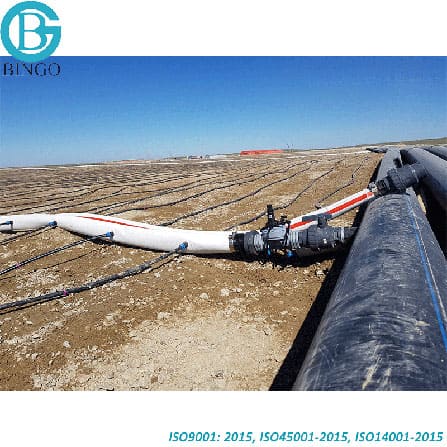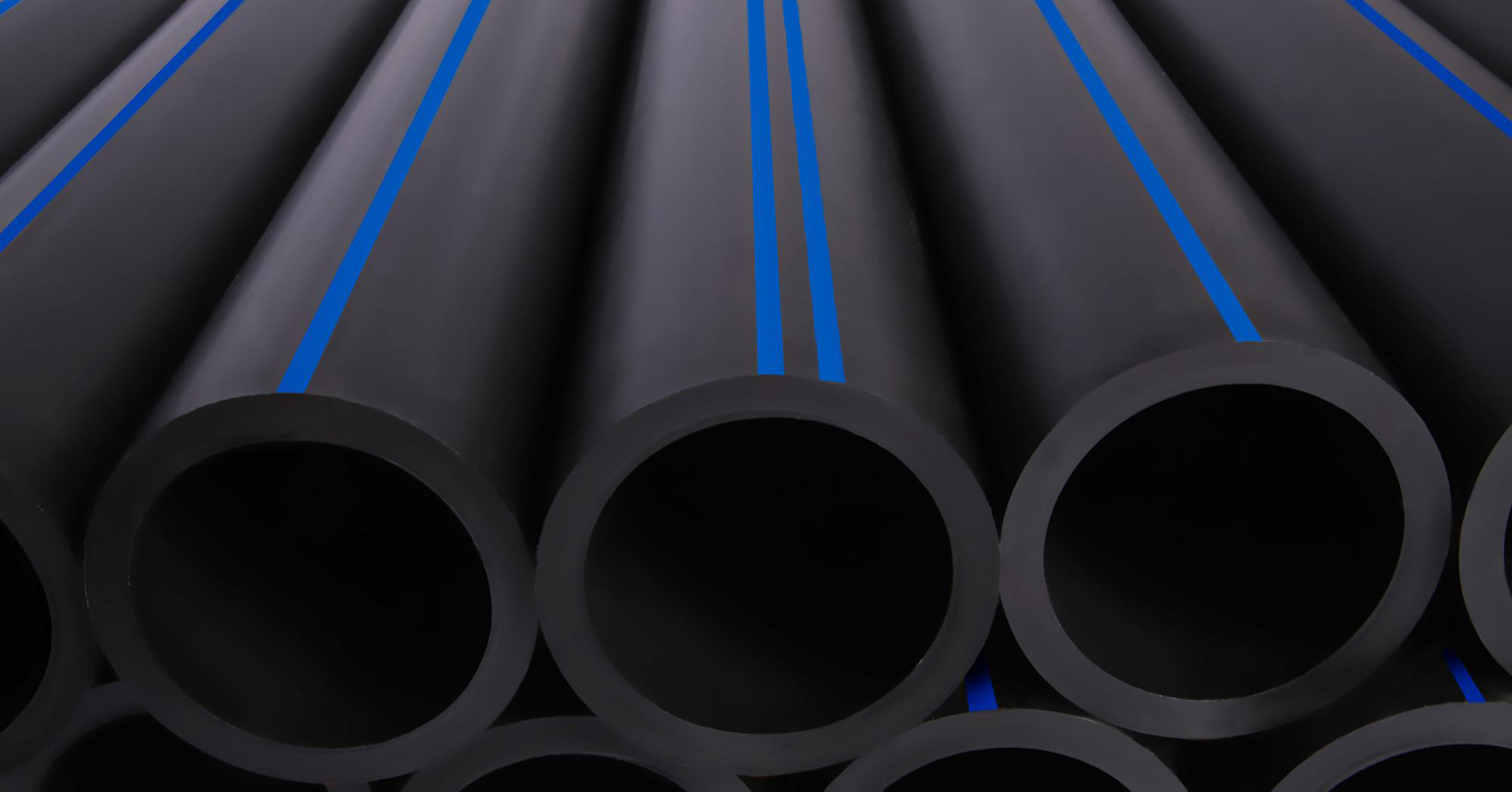Discover the Production Refine Behind High-Quality HDPE Pipeline and Its Applications
The manufacturing procedure of top notch HDPE pipes is detailed and methodical. It starts with the selection of basic materials that enhance performance. Following this, ethylene undergoes polymerization to develop resin, which is after that formed through extrusion. Quality assurance is critical, guaranteeing that the end product meets strict criteria. The journey of HDPE pipelines doesn't finish with production. Their applications throughout numerous markets disclose a wider value worth analyzing.
Comprehending HDPE: Features and Advantages

High-density polyethylene (HDPE) is a versatile polycarbonate recognized for its resilience and resistance to numerous environmental elements. This material displays superb tensile strength, making it appropriate for demanding applications. Its low-density structure contributes to a lightweight item, assisting in simplicity of dealing with and setup. HDPE likewise showcases impressive resistance to chemicals, which lessens deterioration when exposed to rough compounds.
The material's reduced wetness absorption further boosts its long life, making it ideal for usage in pipelines and tank. Additionally, HDPE is immune to ultraviolet (UV) radiation, guaranteeing that items preserve their integrity even when subjected to sunlight. Furthermore, its versatility enables the development of complex shapes without compromising toughness. The green nature of HDPE, often stemmed from recycled products, contributes to its allure, advertising sustainable practices in production. On the whole, these residential or commercial properties and benefits make HDPE a preferred option for numerous industrial and customer applications.
Raw Material Choice for HDPE Manufacturing
The selection of basic materials for HDPE production is vital to verify the last item meets the preferred requirements and quality criteria. High-density polyethylene (HDPE) is mainly created from polymerized ethylene, originated from fossil gas such as gas or petroleum. The high quality of these feedstocks substantially affects the mechanical and thermal residential or commercial properties of the final HDPE.
Additives also play a significant role in enhancing HDPE's performance, including antioxidants, UV stabilizers, and colorants, which improve sturdiness and resistance to environmental elements. The choice process have to take into consideration not just the chemical composition of the raw materials yet additionally their processing features to guarantee efficient production.
The sourcing of raw products ought to focus on sustainability and conformity with environmental guidelines, as liable practices are crucial in today's market. Eventually, careful basic material selection lays the structure for producing top quality HDPE pipelines suitable for varied applications.
The Extrusion Refine: Shaping HDPE Pipeline
The extrusion process plays a crucial function in shaping HDPE pipelines, beginning with meticulous material preparation strategies that guarantee optimal circulation and uniformity. Similarly vital is the style of the die, which directly affects the final measurements and surface top quality of the pipe. With each other, these aspects contribute substantially to the effectiveness and top quality of HDPE pipeline production.
Product Preparation Methods
Efficient production of HDPE pipelines begins with precise product prep work methods, specifically the extrusion procedure. During this stage, high-density polyethylene material is very first dried out to remove dampness, ensuring excellent flow attributes. The resin is then fed into the extruder, where it goes through heating and melting, changing right into a thick state. This home heating process is carefully managed to preserve the product's integrity and efficiency. The liquified HDPE is compelled via a die, forming it into a continual pipeline form. Correct temperature administration throughout extrusion is essential, as it straight influences the material's properties and the final product high quality. As soon as formed, the HDPE pipeline is cooled down and reduced to defined sizes, ready for subsequent handling and applications.
Die Layout Relevance
Precision in die style plays a necessary duty in the extrusion process of HDPE pipes. The die acts as the final shaping device, directly influencing the pipeline's dimensions, wall surface density, and surface area finish. A properly designed die warranties uniform material circulation, lowering flaws such as abnormalities and vulnerable points. The geometry of the die have to be maximized to accommodate the certain residential or commercial properties of HDPE, including its viscosity and thermal actions throughout extrusion. In addition, the cooling rate of the product as it passes with the die can significantly affect the pipeline's architectural integrity. Spending in innovative die modern technology is essential for suppliers intending to produce premium HDPE pipes that meet sector standards and client assumptions.
Quality Assurance Procedures in HDPE Manufacturing
Numerous variables influence the top quality of HDPE pipe manufacturing, efficient high quality control actions are vital to assure consistency and reliability in the final product (custom hdpe pipe manufacturing Midland TX). Trick quality assurance techniques consist of rigorous product inspection, validating that the raw polyethylene meets recognized standards for purity and density. During the extrusion procedure, criteria such as temperature level, stress, and cooling time are closely checked to maintain dimensional accuracy and structural honesty
Furthermore, post-production screening is important; producers often conduct hydrostatic examinations to examine the pipeline's toughness and resistance to stress. Visual evaluations for surface defects further boost quality guarantee. Certification from relevant standards organizations, like ASTM or ISO, supplies an added layer of credibility. By implementing these thorough quality assurance steps, suppliers can reduce issues, improve efficiency, and make sure that the HDPE pipes meet the details demands of numerous applications, eventually resulting in consumer satisfaction and trust fund in the product.
Applications of HDPE Pipeline Across Industries
HDPE pipelines are utilized across numerous sectors because of their longevity and convenience. In water distribution systems, they assure reliable shipment, while in wastewater monitoring, they provide dependable services for waste transportation. In addition, agricultural irrigation networks gain from HDPE's resistance to corrosion and versatility, making it an ideal choice for contemporary farming methods.

Water Circulation Solutions
A considerable variety of markets depend on high-density polyethylene (HDPE) pipelines for effective water distribution systems. Recognized for their toughness and resistance to corrosion, HDPE pipelines are widely utilized in municipal water networks, agricultural watering, and commercial applications. Their lightweight nature facilitates very easy handling and installation, minimizing labor costs and time. Additionally, HDPE pipes can fit numerous stress degrees, making them suitable for both low and high-pressure systems. American Plastics HDPE Pipe for Oilfield. The adaptability of the product permits smooth combination right into existing facilities, decreasing the requirement for extensive excavation. Moreover, HDPE's resistance to chemical leaching warranties that the water delivered stays secure and tidy, making it a suitable selection for maintaining the quality of drinkable water across different markets
Wastewater Monitoring Solutions
Reliable water distribution systems also lead the way for innovative wastewater monitoring remedies, where high-density polyethylene (HDPE) pipelines play a considerable role. Prominent for their durability and resistance to deterioration, HDPE pipes are optimal for transferring wastewater in numerous setups. Their adaptability enables simple installation in intricate atmospheres, lessening the need for extensive excavation. Furthermore, HDPE's smooth indoor surface area reduces rubbing, improving circulation rates and effectiveness. These pipelines are likewise immune to chemical leaching, ensuring that impurities do not endanger the surrounding setting. Industries, municipalities, and treatment facilities progressively rely upon HDPE hop over to these guys pipelines for their integrity and long life, making them a preferred choice for modern wastewater administration systems. This flexibility highlights the crucial relevance of HDPE pipelines throughout many applications.
Agricultural Watering Networks
Agricultural watering networks benefit substantially from more the usage of high-density polyethylene (HDPE) pipes, which offer effective and trustworthy water distribution to plants. HDPE pipes are lightweight, making them easy to transfer and set up, while their versatility allows for various configurations in diverse surfaces. These pipes demonstrate outstanding resistance to corrosion, chemicals, and UV radiation, ensuring sturdiness in rough farming atmospheres. Additionally, their smooth indoor surface area lessens friction loss, enhancing water circulation and decreasing energy prices connected with pumping. The long life of HDPE pipes, usually going beyond half a century, adds to lower maintenance and substitute costs. Consequently, farmers increasingly rely upon HDPE pipelines to enhance watering effectiveness and advertise lasting agricultural techniques, ultimately leading to enhanced plant returns and resource preservation.
Future Fads in HDPE Pipeline Technology
As the demand for lasting and effective framework grows, developments in HDPE pipeline technology are positioned to transform different industries. Arising patterns include the assimilation of wise innovations, such as sensing units and IoT capacities, which promote real-time surveillance of pipe conditions, decreasing maintenance expenses and avoiding leakages. Furthermore, the growth of advanced manufacturing strategies, such as 3D printing, is allowing the production of facility, customized pipeline designs that accommodate particular task demands.
Furthermore, the concentrate on recycling and round economy techniques is driving the advancement of HDPE pipelines made from recycled materials, improving sustainability. Enhanced jointing methods, such as electro-fusion and mechanical fittings, are also improving setup effectiveness and dependability. Finally, the growing emphasis on environmental laws is pushing producers to adopt greener manufacturing procedures, making certain that HDPE pipelines not just satisfy sector requirements however additionally foster a more lasting future for infrastructure growth.
Often Asked Concerns
Exactly How Does HDPE Contrast to Various Other Plastic Materials?
HDPE exceeds lots of other plastic materials regarding sturdiness, chemical resistance, and versatility. Its reduced thickness and high tensile toughness make it perfect for various applications, commonly going beyond choices in both performance and longevity.
What Are the Environmental Impacts of HDPE Manufacturing?
The environmental effects of HDPE production consist of greenhouse gas emissions, power intake, and prospective air pollution from making procedures. Furthermore, improper disposal can cause dirt and water contamination, increasing worries about long-lasting ecological results.
Can HDPE Pipes Be Recycled?
Yes, HDPE pipes can be recycled. Lots of centers accept used HDPE for handling, changing it right into brand-new items. This reusing browse around these guys adds to sustainability efforts, reducing plastic waste while conserving sources and power in the manufacturing cycle.
What Is the Life Expectancy of HDPE Pipeline?

Exactly How Do Temperature Level Variations Impact HDPE Pipe Performance?
Temperature variants considerably impact HDPE pipe efficiency, affecting flexibility and toughness. High temperature levels can result in softening, while low temperature levels might cause brittleness, ultimately influencing the pipeline's toughness and viability for various applications in varied environments.